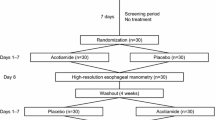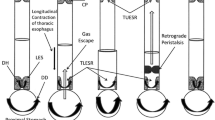Abstract
Findings from recent studies indicate that transient relaxation of the lower esophageal sphincter (LES) is an important contributory mechanism to spontaneous episodes of gastroesophageal reflux (GER) in normal subjects as well as in patients with reflux esophagitis. Our study aim was to evaluate the interrelationship between reduction of LES pressure and elevation of intraabdominal pressure in the induction of GER in healthy subjects. Seven volunteers were studied supine after gastric loading with 0.1 N HCl. A pH probe recorded acid GER. Leg raising (LR) or abdominal compression (AC) were used as stress maneuvers to increase intraabdominal pressure, either alone or in combination with stimuli that concurrently lowered LES pressure, namely multiple rapid swallows (RS) or intraesophageal balloon distention (BD). Each individual stimulus and stimulus combination was tested three times, giving a total of 24 test maneuvers per subject. The test maneuvers elicited 2–12 GERs in each subject. The GER incidence for single maneuvers was: AC, 0%; LR, 0%; RS, 19%; and BD, 24%. LR in combination with RS or BD did not increase the incidence of GER above that induced by RS or BD alone. In contrast, AC concurrent with RS and BD increased the incidence of GER to 52% and 81%, respectively. For all test conditions, a prerequisite for the occurrence of GER was a fall in LES pressure to a minimal value of 3 mm Hg or less. GER never occurred when LES pressure was ≥4 mm Hg, even during intervals of increased intraabdominal pressure. We conclude that (1) virtually complete absence of LES pressure is an essential prerequisite for the induction of GER; (2) during intervals of negligible LES pressure, elevation of intraabdominal pressure increases the prevalence of GER;and (3) LR by normal subjects induces a substantial increase in the abdominal pressure but does not increase GER, probably due to a pinch-cock effect of the diaphragmatic hiatus on the intrahiatal esophageal segment.
Similar content being viewed by others
References
Dodds WJ, Hogan WJ, Miller WN: A report on reflux esophagitis. Am J Dig Dis 21:49–67, 1976
Dodds WJ, Hogan WJ, Helm JF, Dent J: Pathogenesis of reflux esophagitis. Gastroenterology 81:222–225, 1981
Dent J, Dodds WJ, Friedman RH, Sekiguchi T, Hogan WJ, Arndorfer RC: Mechanism of gastroesophageal reflux in recumbent asymptomatic human subjects. J Clin Invest 65:256–267, 1980
Dodds WJ, Dent J, Hogan WJ, Helm JF, Hauser R, Patel GK, Egide MS: Mechanisms of gastroesophageal reflux in patients with reflux esophagitis. N Engl J Med 307:1547–1552, 1982
Dent J: A new technique for continuous sphincter pressure measurement. Gastroenterology 71:263–267, 1976
Arndorfer RC, Stef JJ, Dodds WJ, Linehan JH, Hogan WJ: Improved infusion system for intraluminal esophageal manometry. Gastroenterology 73:23–27, 1977
Behar J, Biancani P, Sheahan DG: Evaluation of esophageal tests in the diagnosis of reflux esophagitis. Gastroenterology 71:9–15, 1976
Fisher RS, Malmud LS, Roberts GS, Lobis IF: Gastroesophageal (GE) scintiscanning to detect and quantitate GE reflux. Gastroenterology 70:301–308, 1976
Lind JF, Warrian WG, Wankling WJ: Responses of the gastroesophageal junctional zone to increases in abdominal pressure. Can J Surg 9:32–38, 1966
Lind JF, Cotton DJ, Blanchard R, Crispin JS, Dimopolos GE: Effect of thoracic displacement and vagotomy on the canine gastroesophageal junctional zone. Gastroenterology 56:1078–1085, 1969
Cohen S, Harris LD: Does hiatus hernia affect competence of the gastroesophageal sphincter? N Engl J Med 284:1053–1056, 1970
Ogilvie AL, Atkinson M: Influence of the vagus nerve upon the reflex control of the lower esophageal sphincter. Gut 25:253–258, 1984
Kaye MD, Showalter JP: Manometric configuration of the lower esophageal sphincter in normal human subjects. Gastroenterology 61:213–223, 1971
Dodds WJ, Hogan WJ, Miller WN, Stef JJ, Arndorfer RC, Lydon SB: Effect of increased intraabdominal pressure on lower esophageal sphincter pressure. Am J Dig Dis 20:298–308, 1975
Dodds WJ, Hogan WJ, Arndorfer RC: Influence of extrinsic forces on intraluminal lower esophageal sphincter pressure.In Proceedings of the Fifth International Symposium on Gastrointestinal Motility. G Vantrappen (ed). Leuven, Belgium, The International Association for the Study of Gastrointestinal Motility, Typoff Press, 1976, p 348
Lepsien G, Schattenmann G, Koelz R, Blum AL, Siewart R: Is the reflex contraction of the lower esophageal sphincter (LES) following an increase of intraabdominal pressure a myth?In Gastrointestinal Motility. J Christensen (ed). New York, Raven Press, 1980, pp 1–10.
Boyle JT, Altschuler SM, Nixon TE, Tuchman DN, Pack AL, Cohen S: Role of the diaphragm in the genesis of lower esophageal sphincter pressure in the cat. Gastroenterology 88:723–730, 1985
Altschuler SM, Boyle JT, Nixon TE, Pack AL, Cohen S: Simultaneous reflex inhibition of lower esophageal sphincter and crural diaphragm in cats. Am J Physiol 12:G586-G591, 1985
Cohen S, Harris LD: The lower esophageal sphincter. Gastroenterology 63:1066–1073, 1972
Monges H, Salducci J, Naudy B: Dissociation between the electrical activity of the diaphragmatic dome and crura muscular fibers during esophageal distention, vomiting and eructation. An electromyographic study in the dog. J Physiol 74:541–554, 1978
Johnson HD, Laws JW: The cardia in swallowing eructation and vomiting. Lancet 2:1268–1273, 1966
Dodds WJ, Stewart ET, Hodges D, Zboralske FF: Movement of the feline esophagus associated with respiration and peristalsis. An evaluation using tantalum markers. J Clin Invest 52:1–13, 1973
Author information
Authors and Affiliations
Additional information
This work was supported, in part, by NIH Research Grants AM 15540 and AM 25731 and a grant from the Boehringer Ingelheim Pharmaceutical Company, Sydney, Australia.
Rights and permissions
About this article
Cite this article
Dent, J., Dodds, W.J., Hogan, W.J. et al. Factors that influence induction of gastroesophageal reflux in normal human subjects. Digest Dis Sci 33, 270–275 (1988). https://doi.org/10.1007/BF01535748
Received:
Revised:
Accepted:
Issue Date:
DOI: https://doi.org/10.1007/BF01535748




